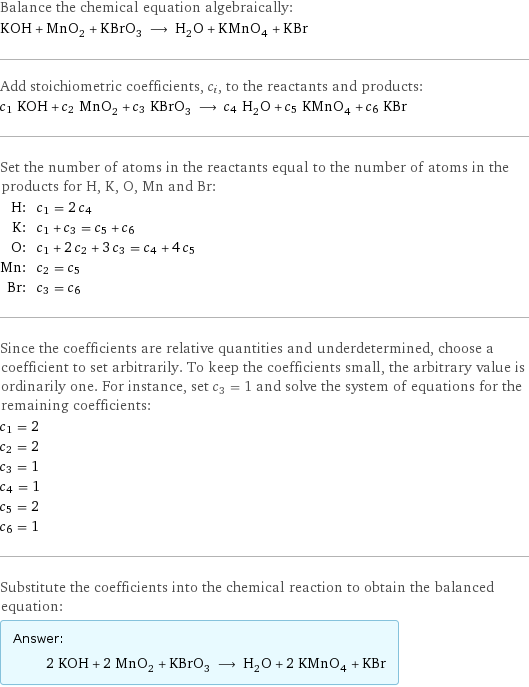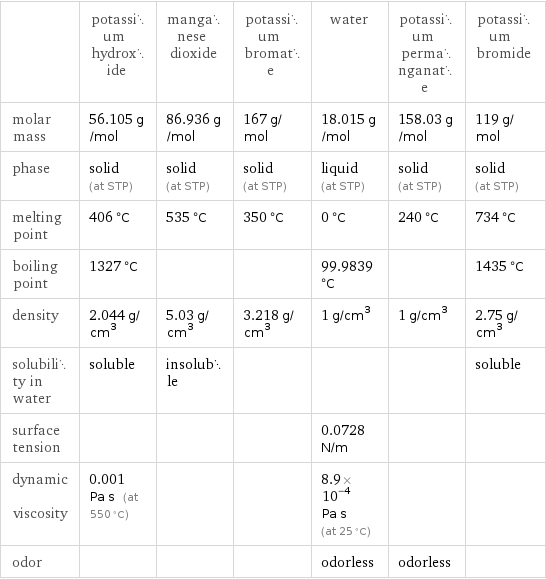Input interpretation

KOH potassium hydroxide + MnO_2 manganese dioxide + KBrO_3 potassium bromate ⟶ H_2O water + KMnO_4 potassium permanganate + KBr potassium bromide
Balanced equation

Balance the chemical equation algebraically: KOH + MnO_2 + KBrO_3 ⟶ H_2O + KMnO_4 + KBr Add stoichiometric coefficients, c_i, to the reactants and products: c_1 KOH + c_2 MnO_2 + c_3 KBrO_3 ⟶ c_4 H_2O + c_5 KMnO_4 + c_6 KBr Set the number of atoms in the reactants equal to the number of atoms in the products for H, K, O, Mn and Br: H: | c_1 = 2 c_4 K: | c_1 + c_3 = c_5 + c_6 O: | c_1 + 2 c_2 + 3 c_3 = c_4 + 4 c_5 Mn: | c_2 = c_5 Br: | c_3 = c_6 Since the coefficients are relative quantities and underdetermined, choose a coefficient to set arbitrarily. To keep the coefficients small, the arbitrary value is ordinarily one. For instance, set c_3 = 1 and solve the system of equations for the remaining coefficients: c_1 = 2 c_2 = 2 c_3 = 1 c_4 = 1 c_5 = 2 c_6 = 1 Substitute the coefficients into the chemical reaction to obtain the balanced equation: Answer: | | 2 KOH + 2 MnO_2 + KBrO_3 ⟶ H_2O + 2 KMnO_4 + KBr
Structures

+ + ⟶ + +
Names

potassium hydroxide + manganese dioxide + potassium bromate ⟶ water + potassium permanganate + potassium bromide
Reaction thermodynamics
Gibbs free energy

| potassium hydroxide | manganese dioxide | potassium bromate | water | potassium permanganate | potassium bromide molecular free energy | -379.4 kJ/mol | -465.1 kJ/mol | -2712 kJ/mol | -237.1 kJ/mol | -737.6 kJ/mol | -380.7 kJ/mol total free energy | -758.8 kJ/mol | -930.2 kJ/mol | -2712 kJ/mol | -237.1 kJ/mol | -1475 kJ/mol | -380.7 kJ/mol | G_initial = -4401 kJ/mol | | | G_final = -2093 kJ/mol | | ΔG_rxn^0 | -2093 kJ/mol - -4401 kJ/mol = 2308 kJ/mol (endergonic) | | | | |
Equilibrium constant
![Construct the equilibrium constant, K, expression for: KOH + MnO_2 + KBrO_3 ⟶ H_2O + KMnO_4 + KBr Plan: • Balance the chemical equation. • Determine the stoichiometric numbers. • Assemble the activity expression for each chemical species. • Use the activity expressions to build the equilibrium constant expression. Write the balanced chemical equation: 2 KOH + 2 MnO_2 + KBrO_3 ⟶ H_2O + 2 KMnO_4 + KBr Assign stoichiometric numbers, ν_i, using the stoichiometric coefficients, c_i, from the balanced chemical equation in the following manner: ν_i = -c_i for reactants and ν_i = c_i for products: chemical species | c_i | ν_i KOH | 2 | -2 MnO_2 | 2 | -2 KBrO_3 | 1 | -1 H_2O | 1 | 1 KMnO_4 | 2 | 2 KBr | 1 | 1 Assemble the activity expressions accounting for the state of matter and ν_i: chemical species | c_i | ν_i | activity expression KOH | 2 | -2 | ([KOH])^(-2) MnO_2 | 2 | -2 | ([MnO2])^(-2) KBrO_3 | 1 | -1 | ([KBrO3])^(-1) H_2O | 1 | 1 | [H2O] KMnO_4 | 2 | 2 | ([KMnO4])^2 KBr | 1 | 1 | [KBr] The equilibrium constant symbol in the concentration basis is: K_c Mulitply the activity expressions to arrive at the K_c expression: Answer: | | K_c = ([KOH])^(-2) ([MnO2])^(-2) ([KBrO3])^(-1) [H2O] ([KMnO4])^2 [KBr] = ([H2O] ([KMnO4])^2 [KBr])/(([KOH])^2 ([MnO2])^2 [KBrO3])](../image_source/32c9a62f5d189ccf4f6af002a15f8bab.png)
Construct the equilibrium constant, K, expression for: KOH + MnO_2 + KBrO_3 ⟶ H_2O + KMnO_4 + KBr Plan: • Balance the chemical equation. • Determine the stoichiometric numbers. • Assemble the activity expression for each chemical species. • Use the activity expressions to build the equilibrium constant expression. Write the balanced chemical equation: 2 KOH + 2 MnO_2 + KBrO_3 ⟶ H_2O + 2 KMnO_4 + KBr Assign stoichiometric numbers, ν_i, using the stoichiometric coefficients, c_i, from the balanced chemical equation in the following manner: ν_i = -c_i for reactants and ν_i = c_i for products: chemical species | c_i | ν_i KOH | 2 | -2 MnO_2 | 2 | -2 KBrO_3 | 1 | -1 H_2O | 1 | 1 KMnO_4 | 2 | 2 KBr | 1 | 1 Assemble the activity expressions accounting for the state of matter and ν_i: chemical species | c_i | ν_i | activity expression KOH | 2 | -2 | ([KOH])^(-2) MnO_2 | 2 | -2 | ([MnO2])^(-2) KBrO_3 | 1 | -1 | ([KBrO3])^(-1) H_2O | 1 | 1 | [H2O] KMnO_4 | 2 | 2 | ([KMnO4])^2 KBr | 1 | 1 | [KBr] The equilibrium constant symbol in the concentration basis is: K_c Mulitply the activity expressions to arrive at the K_c expression: Answer: | | K_c = ([KOH])^(-2) ([MnO2])^(-2) ([KBrO3])^(-1) [H2O] ([KMnO4])^2 [KBr] = ([H2O] ([KMnO4])^2 [KBr])/(([KOH])^2 ([MnO2])^2 [KBrO3])
Rate of reaction
![Construct the rate of reaction expression for: KOH + MnO_2 + KBrO_3 ⟶ H_2O + KMnO_4 + KBr Plan: • Balance the chemical equation. • Determine the stoichiometric numbers. • Assemble the rate term for each chemical species. • Write the rate of reaction expression. Write the balanced chemical equation: 2 KOH + 2 MnO_2 + KBrO_3 ⟶ H_2O + 2 KMnO_4 + KBr Assign stoichiometric numbers, ν_i, using the stoichiometric coefficients, c_i, from the balanced chemical equation in the following manner: ν_i = -c_i for reactants and ν_i = c_i for products: chemical species | c_i | ν_i KOH | 2 | -2 MnO_2 | 2 | -2 KBrO_3 | 1 | -1 H_2O | 1 | 1 KMnO_4 | 2 | 2 KBr | 1 | 1 The rate term for each chemical species, B_i, is 1/ν_i(Δ[B_i])/(Δt) where [B_i] is the amount concentration and t is time: chemical species | c_i | ν_i | rate term KOH | 2 | -2 | -1/2 (Δ[KOH])/(Δt) MnO_2 | 2 | -2 | -1/2 (Δ[MnO2])/(Δt) KBrO_3 | 1 | -1 | -(Δ[KBrO3])/(Δt) H_2O | 1 | 1 | (Δ[H2O])/(Δt) KMnO_4 | 2 | 2 | 1/2 (Δ[KMnO4])/(Δt) KBr | 1 | 1 | (Δ[KBr])/(Δt) (for infinitesimal rate of change, replace Δ with d) Set the rate terms equal to each other to arrive at the rate expression: Answer: | | rate = -1/2 (Δ[KOH])/(Δt) = -1/2 (Δ[MnO2])/(Δt) = -(Δ[KBrO3])/(Δt) = (Δ[H2O])/(Δt) = 1/2 (Δ[KMnO4])/(Δt) = (Δ[KBr])/(Δt) (assuming constant volume and no accumulation of intermediates or side products)](../image_source/8ea3cb4595c8634809a9e23d81295ddd.png)
Construct the rate of reaction expression for: KOH + MnO_2 + KBrO_3 ⟶ H_2O + KMnO_4 + KBr Plan: • Balance the chemical equation. • Determine the stoichiometric numbers. • Assemble the rate term for each chemical species. • Write the rate of reaction expression. Write the balanced chemical equation: 2 KOH + 2 MnO_2 + KBrO_3 ⟶ H_2O + 2 KMnO_4 + KBr Assign stoichiometric numbers, ν_i, using the stoichiometric coefficients, c_i, from the balanced chemical equation in the following manner: ν_i = -c_i for reactants and ν_i = c_i for products: chemical species | c_i | ν_i KOH | 2 | -2 MnO_2 | 2 | -2 KBrO_3 | 1 | -1 H_2O | 1 | 1 KMnO_4 | 2 | 2 KBr | 1 | 1 The rate term for each chemical species, B_i, is 1/ν_i(Δ[B_i])/(Δt) where [B_i] is the amount concentration and t is time: chemical species | c_i | ν_i | rate term KOH | 2 | -2 | -1/2 (Δ[KOH])/(Δt) MnO_2 | 2 | -2 | -1/2 (Δ[MnO2])/(Δt) KBrO_3 | 1 | -1 | -(Δ[KBrO3])/(Δt) H_2O | 1 | 1 | (Δ[H2O])/(Δt) KMnO_4 | 2 | 2 | 1/2 (Δ[KMnO4])/(Δt) KBr | 1 | 1 | (Δ[KBr])/(Δt) (for infinitesimal rate of change, replace Δ with d) Set the rate terms equal to each other to arrive at the rate expression: Answer: | | rate = -1/2 (Δ[KOH])/(Δt) = -1/2 (Δ[MnO2])/(Δt) = -(Δ[KBrO3])/(Δt) = (Δ[H2O])/(Δt) = 1/2 (Δ[KMnO4])/(Δt) = (Δ[KBr])/(Δt) (assuming constant volume and no accumulation of intermediates or side products)
Chemical names and formulas

| potassium hydroxide | manganese dioxide | potassium bromate | water | potassium permanganate | potassium bromide formula | KOH | MnO_2 | KBrO_3 | H_2O | KMnO_4 | KBr Hill formula | HKO | MnO_2 | BrKO_3 | H_2O | KMnO_4 | BrK name | potassium hydroxide | manganese dioxide | potassium bromate | water | potassium permanganate | potassium bromide IUPAC name | potassium hydroxide | dioxomanganese | potassium bromate | water | potassium permanganate | potassium bromide
Substance properties

| potassium hydroxide | manganese dioxide | potassium bromate | water | potassium permanganate | potassium bromide molar mass | 56.105 g/mol | 86.936 g/mol | 167 g/mol | 18.015 g/mol | 158.03 g/mol | 119 g/mol phase | solid (at STP) | solid (at STP) | solid (at STP) | liquid (at STP) | solid (at STP) | solid (at STP) melting point | 406 °C | 535 °C | 350 °C | 0 °C | 240 °C | 734 °C boiling point | 1327 °C | | | 99.9839 °C | | 1435 °C density | 2.044 g/cm^3 | 5.03 g/cm^3 | 3.218 g/cm^3 | 1 g/cm^3 | 1 g/cm^3 | 2.75 g/cm^3 solubility in water | soluble | insoluble | | | | soluble surface tension | | | | 0.0728 N/m | | dynamic viscosity | 0.001 Pa s (at 550 °C) | | | 8.9×10^-4 Pa s (at 25 °C) | | odor | | | | odorless | odorless |
Units
